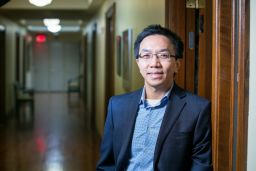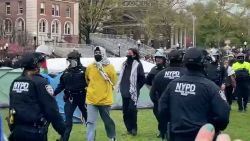Editor’s Note: Jennifer Lee is professor of sociology at Columbia University and president-elect of the Eastern Sociological Society. Van C. Tran is associate professor of sociology at The Graduate Center, CUNY. The views expressed here are theirs. Read more opinion on CNN.
A new academic year is underway, and universities nationwide await the verdict in the latest case placing affirmative action on trial.


In Students for Fair Admissions v. Harvard, the plaintiffs allege that Harvard discriminates against Asian applicants by holding them to a higher academic standard, and rating them poorly on personal characteristics in order to artificially suppress their rate of admission. Their solution, expressed in a suit that the plaintiffs hope will reach the US Supreme Court, is to ban the consideration of race and ethnicity in all admissions decisions.
Missing from the current debate is a fundamental question that the plaintiffs chose not to raise: should we treat non-white groups as equally disadvantaged? Alternatively, should we account for the different kinds, degrees and consequences of non-white disadvantage?
Asians are divided on this issue. Supporters argue that affirmative action is necessary to address past discrimination against African Americans, and to create diverse schools and workplaces that reflect the racial and ethnic demography of the US population. Opponents decry the moral failing of an antiquated policy that privileges group membership over meritocratic ideals, in which Asians are the newest victims.
Our new research shows that the divide among Asians is generational. Based on the 2016 National Asian American Survey, we found that Asian immigrants are least likely to support affirmative action. By contrast, Asians born in the US with parents who were also born here – the so-called later generation – are most likely to do so. In fact, later-generation Asians are more likely to support affirmative action than Asian immigrants by a factor of three.
What explains the difference between foreign-born and later-generation Asians?
Most Asian immigrants come from countries that lack affirmative action, so they are less likely to understand the historical origins of a policy that was designed to rectify past discrimination against blacks by whites. Their unfamiliarity explains only part of their resistance. Their reticence also stems from their exclusion from affirmative action despite the fact they, too, experience bias and discrimination.
Language barriers, foreign accents and cultural biases against newcomers often make it difficult for many highly educated Asian immigrants to transfer their university degrees, job skills and work experience from their home countries to the US labor market. As a result, many have no choice but to accept jobs for which they are overqualified and underpaid, resulting in an “occupational mismatch.”
The occupational mismatch is evident among highly educated Korean immigrants who once worked as doctors, lawyers and engineers in Korea, but now run small businesses in poor, black neighborhoods.
As newcomers to the US, many immigrants from a variety of countries of origin are prepared to expect situations like this.
But even US-born Asians do not earn as much as comparably educated whites even after accounting for college type, major, metropolitan area and years of experience.
This places Asians in a unique bind: in spite of their labor market disadvantage and non-white minority status, Asians also lack the legacy of disadvantage of blacks that make them eligible beneficiaries of affirmative action. Hence, some Asian immigrants feel like they are both victims of discrimination and victims of affirmative action who are penalized for their race while blacks and other minorities are rewarded for theirs.
Undergirding this sentiment is what we call the false equivalency of non-white disadvantage, which treats all racial minority groups as though they are equally disadvantaged. Asians may be a disadvantaged minority relative to whites, but they are also an advantaged minority relative to blacks.
As non-whites, Asians have endured immigration restrictions, legal exclusion from US citizenship, anti-Asian hostility, violence, prejudice and even internment. But as non-blacks, Asians have escaped centuries of slavery, the legal codification of racial inferiority, the cumulative and intergenerational disadvantages that blacks have endured as a result.
The false equivalency of nonwhite disadvantage is even more apparent in the context of contemporary Asian immigration. Of the five largest Asian immigrant groups in the US – Chinese, Indians, Filipinos, Vietnamese, and Koreans – each is more likely to have a college degree than blacks, and all except Vietnamese are more likely than whites.
This educational edge becomes even more pronounced among their US-born children who soar past both blacks and whites.
We have found that many Asians whose families have been in the US for several generations – arguably the most assimilated – refuse to fall prey to the false equivalency. They better understand their class advantage over African Americans and other nuances of context.
In fact, many later-generation Asians, like blacks, are most likely to support affirmative action as it was originally designed and intended—to redress past wrongs against blacks by whites.
As the battle over affirmative action rages on, Harvard’s alleged preference for athletes, legacies, students on the dean’s interest list and the children of faculty and staff goes unchecked. The main beneficiaries of these admissions preferences, as recent research has shown: white applicants. Among white students admitted to Harvard between 2009 and 2015, 43% fell into one of these special categories. The comparable figure for Asian, black, and Hispanic admitted students is only 16%.
More astounding is these special preferences tip the scale so heavily for white students that about three-quarters would have been rejected had they not belonged to one of these preference categories.
But rather than attempting to dismantle Harvard’s preference for athletes, legacies and students of donor’s, faculty and staff, the plaintiffs have focused on trying to dismantle Harvard’s consideration of race and ethnicity. Dismantling Harvard’s institutional preference for those in the former category would increase the chances of admission not only for Asian American applicants, but for a broad range of students from different race and class backgrounds.




















